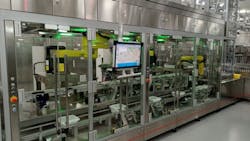Robot orders in life sciences, pharma up 22% in Q2 in push for operational efficiency
Second-quarter 2025 data show robot orders increased by 22% year-over-year in the life sciences and pharmaceutical industry, the strongest sector growth in Q2, according to the Association for Advancing Automation (A3).
The quarterly results for the North American industrial robotics market continue to show momentum as companies are investing in robots to reduce errors and enhance quality control, among other business goals.
Alex Shikany, executive vice president at A3, told Pharma Manufacturing that the Q2 data reflect the expanding role of automation in life sciences and pharmaceuticals amid an evolving macroeconomic environment including reshoring, labor shortages, and the industry’s push for greater operational efficiency.
Shikany said there are “very strict regulations in the life sciences and pharmaceutical industries” and one of the key benefits of robotics and automation are they provide sterile manufacturing environments, helping to mitigate the risks of contamination.
The stakes are high for pharma products to remain contaminant-free as it can compromise the sterility of a drug, according to Shikany, who points to manufacturing applications such as fill-finish where automation and robotics help ensure sterile environments.
“The customers in that space are now viewing automation and robotics differently than they were say 10 years ago,” Shikany said. “They’re viewing it more as a core necessity to their manufacturing infrastructure, and not so much as a supplemental or nice-to-have element.”
Eli Lilly uses robotics extensively in various parts of its operations in Concord, North Carolina, which started commercial production at the end of 2024, including high-speed lines, forklift-like autonomous guided vehicles (AGVs), and a fully automated warehouse.
When it comes to fulfillment, warehousing, and distribution, Shikany said those are strong-growth applications for technologies such as AGVs, autonomous forklifts, and mobile robots.
“Having more of a closed system that is more automated and can be monitored is desirable from a customer standpoint,” Shikany said. “It’s really about the value that robots provide to supplement human employees. Human-in-the-loop automation is the phase we’re headed into.”
Collaborative robots (cobots), which work alongside humans and address automation needs in space- or labor-constrained environments, are a growing share of the market and in Q2 2025 made up 23.7% of all units and 14.7% of revenue, according to A3’s data.
“It’s a type of robot that’s manufactured with sensors and different environmental awareness technologies,” Shikany said. “Collaborative robots can be deployed on a line right next to a human employee, who can handguide that robot.”
A3 began tracking cobots as a distinct category in Q1 2025 and plans to expand future reporting to include quarterly growth trends by sector such as life sciences and pharma.
About the Author
Greg Slabodkin
Editor in Chief
As Editor in Chief, Greg oversees all aspects of planning, managing and producing the content for Pharma Manufacturing’s print magazines, website, digital products, and in-person events, as well as the daily operations of its editorial team.
For more than 20 years, Greg has covered the healthcare, life sciences, and medical device industries for several trade publications. He is the recipient of a Post-Newsweek Business Information Editorial Excellence Award for his news reporting and a Gold Award for Best Case Study from the American Society of Healthcare Publication Editors. In addition, Greg is a Healthcare Fellow from the Society for Advancing Business Editing and Writing.
When not covering the pharma manufacturing industry, he is an avid Buffalo Bills football fan, likes to kayak and plays guitar.
